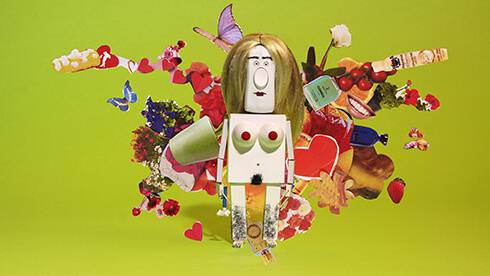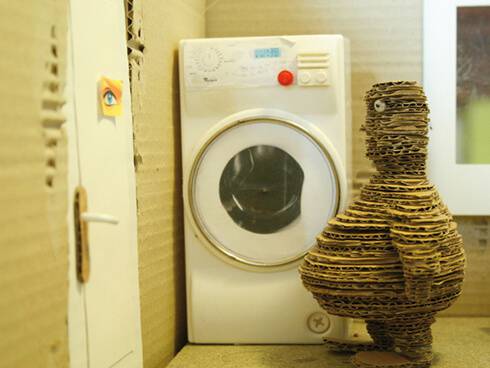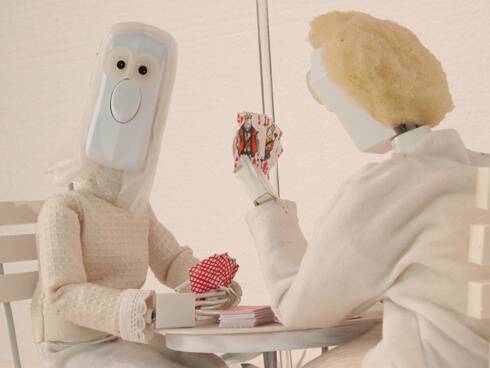Interview with ‘Toutes Nuancées’ director Chloé Alliez
French-born director Chloé Alliez is a new talent to watch out for, having recently graduated from the illustrious visual arts school La Cambre with an MA in Animation following a prior bachelor’s degree in Illustration. Among the four stop-motion shorts she produced during her studies is the particularly witty and poignant Toutes Nuancées (All Their Shades). Making effective use of found objects (in particular light switches) the film is a celebration of – and tribute to – womankind in all its idiosyncratic glory and has since been well-received at festivals, winning the FANtastischer Prize at the Stuttgart International Festival of Animated Film and Best Short Film at Toronto Queer West Film Festival earlier this year. Skwigly were eager to hear more about the processes of this gifted filmmaker and what governs her appealingly unique approach.
Coming from a background having studied illustration, what motivated you to progress onto animation for your MA?
During my illustration studies I had always been doing animation. Each year we had to make a personal project, and while everyone was making a book, I always made a short film instead. Of course it wasn’t very professional. I used to shoot my films between my kitchen and my bathroom, without a computer, only on the tiny screen of my compact camera! One of my teachers, Thierry Van Asselt, really encouraged me to continue animation in La Cambre.
What was behind the decision to make an animated love letter to womankind?
Because I love women! I wanted to talk about homosexuality, and to show that as a woman, I have the same reasons to love women as men do.
Do you have any strong feelings about the role of women as far as they are depicted in animation in general?
I’m not very sure if there is a positive evolution for women within animation. Of course there are movies with female main characters, such as Tout en haut du monde and Avril et le monde Truqué. These women are less passive than Cendrillon and Blanche Neige! For most of the commercial field, like TV series, it’s still rare to find a woman at the forefront. Luckily this problem is less perceptible in independent productions, especially for short films that are more creative, with personal stories.
Of course, there are still too many films that are kept under the influence of a very classical and conservative point of view of male and female roles in society (even if it’s not a conscious choice), but in general, I feel like there is an evolution (maybe slow but in a good direction) showing that young directors are not indifferent to this topic.

Toutes Nuancées (Dir. Chloé Alliez)
A lot of the humour comes from a very effective juxtaposition of a romanticised narration and more realistic, idiosyncratic depictions as far as the animation itself is concerned. In this respect was the film made as a response to this kind of female-idealism (you mention on your site the phrase ‘stereotypical vision’)?
Yes, exactly. I wanted to show the absurdity of some clichés and make fun of them. Many sentences in the film seem really too stereotypical (some people even thought it was a misogynist movie because they didn’t get the sarcasm!). But it’s a fact: when I asked men around me they gave me these kind of answers. In our societies, women are always associated with this picture of beautiful creature and perfect mother: So when you are a woman, it’s hard to disconnect from this and to just be considered as a person.
Did the narration as written come first and determine the visuals, or did you embark on the project with certain visual scenarios in mind already?
In the beginning I had a few ideas of funny discrepancies between the voice and the pictures. Of course it wasn’t enough! I tried to find clear reasons to love women, whether stereotypical, serious or even very personal. First it was difficult to get ideas but as time went on I found I couldn’t stop! The story would build even after the shooting had begun. When I found a funny accessory I thought immediately “I have to find a sketch with that!”. So the narration and the visuals fed each other.
The choice of narrator is quite important as far as reveal in the final shot is concerned. What was your main reasoning behind this choice?
The choice of the narrator was very very important indeed! And difficult! All the ideas were based on this ending revelation. The audience is supposed to imagine they are the words of a man. Then, at the end, the spectator understands it’s a woman who speaks about her reasons to love women, the same that a man could have had! I wanted to record a female voice but unfortunately it didn’t work. We recognized the femininity in the voice (even in a very deep one) when I asked them for more punch. Luckily someone gave me the contact of the actor Pierre-Paul Constant and he was just perfect!

Joyeux Anniversaire (Dir. Chloé Alliez)
A lot of your scenarios and puppets tend to repurpose found objects and miscellaneous debris, have you always had this impulse with your creative work?
It’s because I’m poor! No, just kidding! I love to collect objects I find in the street or in shops and imagine a character with these crazy elements alone, or added to others. It’s magical to give them a new vision, a new utility! I always built strange things with paper mixed with Lego and what I had in front of me. I’m not fond of clay or latex. Of course you are free to give them the style you want but I prefer when the objects decide for me! In my earlier movies I used soft materials for the bodies to get fluidity on the movements. The faces don’t have many possibilities of expression. For me, it’s not necessary because the objects I use for faces are already very strong and meaningful.
In the lead-up to Toutes Nuancées you produced several other short films, are there any of these you have a particular fondness for as far as their production/final result went? And was the experience of any of them particularly important when it came to approaching the production for your final film?
My first movie when I arrived in La Cambre helped me a lot! With La Tache I discovered professional materials, I stopped to do my shooting in my small flat and I was happy to discover Dragonframe! I also used professional armatures for the first time. The short Oh My Dog! was more difficult to produce, in an emotional sense, but I loved so much hearing people laugh during the screenings!

La Tache (Dir. Chloé Alliez)
I note that light switches in particular are a recurring motif in your puppets, how did this decision come about?
I had this revelation for La Tache – it works so well, I loved it! To be honest, during the production of Toutes Nuancées I had a serious addiction problem; I always wanted to find a new model. All my friends hid their lamps from me!
Interestingly your illustration work seems to be largely craft-based in keeping with your animation style. Are there any particular artists who do likewise that you take inspiration from?
I’m really impressed about the creativity of PES’s shorts. He gives life to those objects from everyday life – a tool becomes a fish, a pizza becomes Pac-Man, sofas have sexuality! Today it’s not surprising to see films in stop-motion using real objects and even showing the hands of the animator. The way of the production seems as important as the result. I like this idea!
How did you find your time at the University of South Wales and the production of For Fork’s Sake? Were there any major benefits or effects on your work from the experience there/the people you met?
My Erasmus was a beautiful experience. I met people who are not artists or animators for once! In spite of this, they helped me very often. I spent a lot of time improving my English and maybe less on my work. This is why I’m still working on it now!
What are you working on next?
I will try to finish For Fork’s Sake, mainly for the sound. After my studies I worked on a music video in cut-out animation with someone else and also animated on a commercial in stop motion in London. Now I’m doing either post-production or compositing because it’s very hard to find a project in stop-motion. And while I’m sending my CV everywhere in the universe, I’m starting to write a new film. Also, I have a very great project together with my partener. It’s an animation series, itinerant and participative. We will travel with our puppet and in each episode insert her into a new environment built by a group in a workshop.
See more of Chloé Alliez’s work at chloealliez.com

